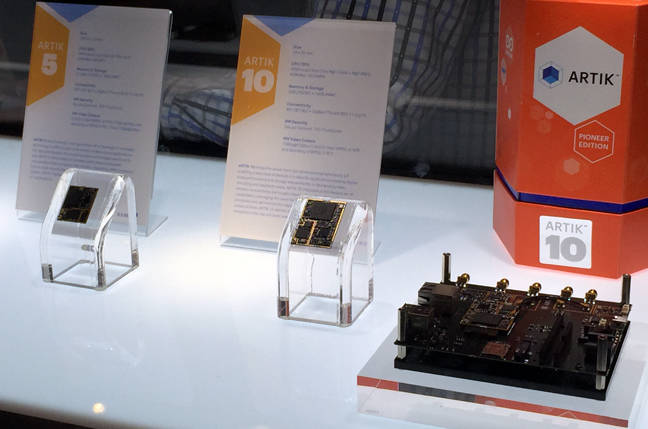This article is more than 1 year old
Samsung debuts Artik, its new software n' chips for the Internet of Stuff
Three models aimed at powering the guts of robots, drones, and devices
Artik 10: Power the size of a big postage stamp
If you want even more oomph for your devices, however, Samsung offers the Artik 10. This one comes in a package that's once again physically larger than the Artik 5, but it includes features that give it power comparable to a high-end smartphone.
For CPU, it's got eight cores: four ARM A15s clocked at 1.3GHz apiece and four ARM A7s clocked at 1.0GHz each. For memory it has 2GB of LPDDR3+ RAM and 16GB of eMMC storage. Graphics are handled by an ARM Mali T628 MP6 GPU, which lets it push full 1080p HD video at 120fps.
The Artik 10 has similar communications capabilities to the Artik 5, but more and better, including a USB 3.0 port in addition to the Artik 5's USB 2.0 port. It supports multi-channel hardware audio decoding, which makes this module well suited to multimedia applications.
Pick your programming poison
Samsung is calling Artik an IoT "platform," and it wouldn't much deserve the name if a few silicon packages was all that was on offer. The Korean firm is also providing a number of software options for Artik device developers, allowing them to choose from Samsung's own platforms or familiar ones from elsewhere in the embedded world.
Where OS is concerned, the Artik 1 is the oddball of the three Artik modules. It runs the Nucleus OS, a realtime operating system (RTOS) developed by Mentor Graphics that Samsung has used in its Touch phones in the past. The Artik 5 and Artik 10, meanwhile, are running Yocto 1.6, a customized embedded Linux distribution based on Fedora.

Samsung had Artik on display at Internet of Things World, but getting your hands on it could take a while
As for how you want to build your applications on top of the OS, that's up to you. Samsung says it will provide an SDK for all three modules (naturally) and all three support development in C/C++. The Artik 5 and Artik 10 also add support for Java and Groovy.
Not looking to reinvent the wheel, however, and realizing the value of the existing device maker community, Samsung has enrolled Artik in the Arduino Certified Program, which allows Artik devices to be developed using the Arduino IDE. Other devices in the program include Intel's Galileo and Edison developer boards.
Not all there yet
Developers eager to roll their sleeves up with Artik are going to have to be patient, however. Samsung has signed up a few partners for the launch, including analytics outfit Medium One, "smart home" vendor SmartThings (actually a Samsung subsidiary, and Temboo, an IoT tools vendor that has already built a smart water tank using Sammy's tech.
But if you aren't one of Samsung's pilot partners, it's early days yet. The chaebol is only now taking applications from device makers who want to sign up for an alpha version of the Artik development kit, and it says there are only a limited number of slots.
Developers who make it into the program will gain "access to hardware, technical support, connect directly with the product team for assistance and feedback." To sign up, though, you'll first need a Samsung account. ®
